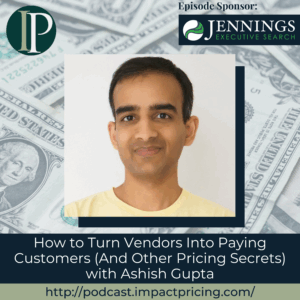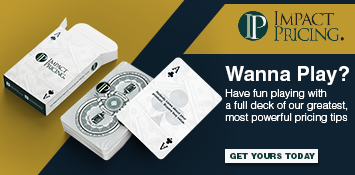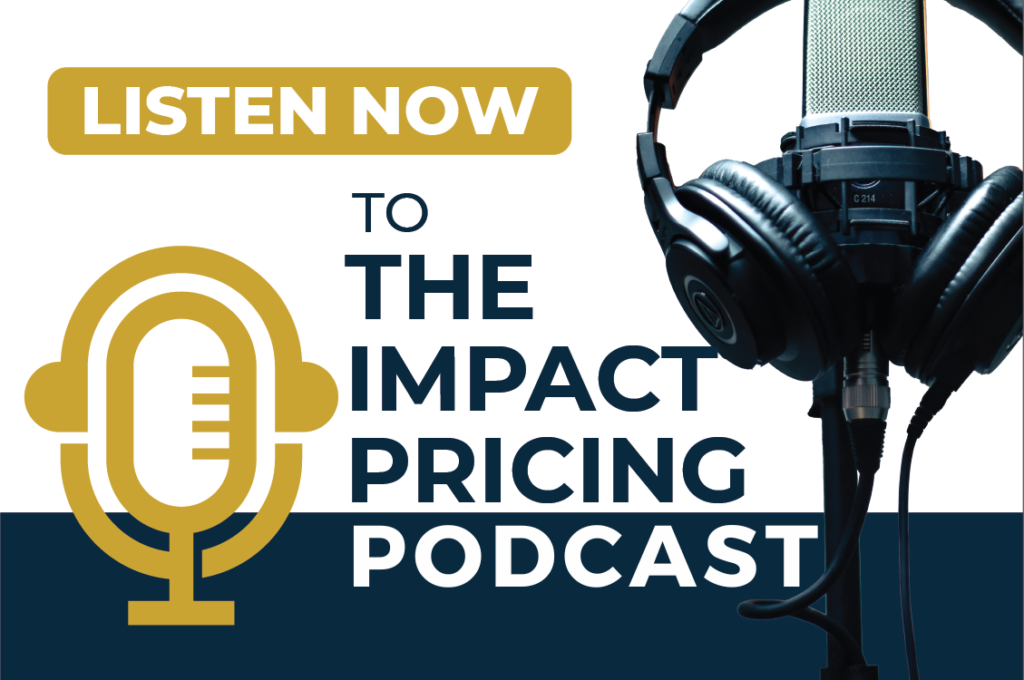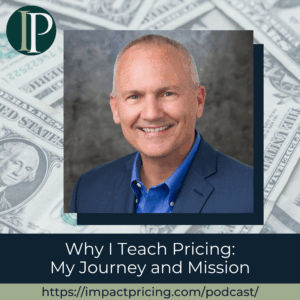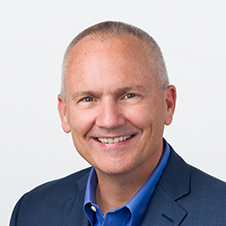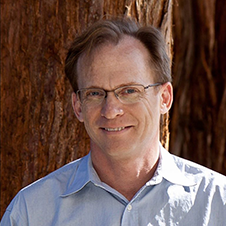Ashish Gupta, founder and CEO of ScaleUp Exec, brings a unique perspective to pricing from his experience building and selling multiple companies across technology, e-commerce, and subscription businesses. Starting his career at Anheuser-Busch (as the company’s only non-drinker), Ashish has led businesses from startup to eight-figure valuations, giving him deep insights into pricing across different business models and growth stages.
In this episode, Ashish shares unconventional pricing strategies that transformed his businesses, including how he convinced vendors to provide products for free by repositioning his company as a marketing partner rather than a traditional retailer.
Podcast: Play in new window | Download
Why you have to check out today’s podcast:
- Discover how to identify and target the specific customer segments willing to pay premium prices for your unique value proposition.
- Learn the “influencer plus” strategy that transforms vendor relationships from cost centers into revenue-generating partnerships.
- Understand how subscription businesses create deeper customer relationships and the pricing implications of holding customer credit cards.
“Instead of trying to go to a general audience, which may or may not be interested in paying you more for something unique about your product, really try and understand who is that core set of people that will find real value and be willing to pay for that value.”
– Ashish Gupta
Topics Covered:
01:48 — Ashish’s entrepreneurial journey: From Anheuser-Busch to multiple successful exits.
03:42 — The psychology of subscription pricing: Why holding credit cards creates deeper customer relationships.
07:54 — Win, Keep, Grow framework: The often-overlooked “grow” component in subscription businesses.
11:03 — ScaleUp Exec’s fractional COO model: Bringing enterprise talent to small and medium businesses.
13:45 — Revenue growth strategies: How COOs approach customer acquisition and diversification differently.
17:34 — The pricing audit revelation: Why PE firms consistently find underpriced acquisitions.
22:01 — The “off balance sheet CFO” positioning strategy for premium pricing.
22:58 — The vendor flip strategy: From paying wholesale to getting products for free.
24:04 — Building the “influencer plus” model: Combining audience and distribution for vendor value.
Key Takeaways:
“I think relationship and subscription are, they kind of go hand in hand. That means I have to always be getting value. I have to have this confidence that, if somebody has my credit card and I’ve given them authorization to charge it versus like, let’s say an Amazon, I’m proactively going in and saying, yes, I want this item.” – Ashish Gupta
“If we can build out our own audience, and grow that audience to be something meaningful and have a deep connection with that audience so that they really trust us, our brand as a retailer, then we can actually talk with our vendors and say, hey, we’re no longer a retailer, we’re really a marketing company.” – Ashish Gupta
Resources and People Mentioned:
- Anheuser-Busch: https://www.anheuser-busch.com
- Shopify Shop Pay: https://www.shopify.com/shop-pay
- PayPal: https://www.paypal.com/
- Mark Stiving’s book: “Win, Keep, Grow” about subscription businesses
Connect with Ashish Gupta:
- Website: https://scaleupexec.com/
- Linkedin: https://www.linkedin.com/in/ashish-gup/
Connect with Mark Stiving:
- LinkedIn: https://www.linkedin.com/in/stiving/
- Email: [email protected]
Full Interview Transcript
(Note: This transcript was created with an AI transcription service. Please forgive any transcription or grammatical errors. We probably sounded better in real life.)
Ashish Gupta
Really understand who are the unique set of people out there that might be willing to pay more for you. Instead of trying to go to a general audience, which may or may not be interested in paying you more for something unique about your product, really try and understand who is that core set of people that will find real value and be willing to pay for that value.
[Intro / Ad]
Mark Stiving
Welcome to Impact Pricing, the podcast where we discuss pricing, value, and the measured relationship between them. I’m Mark Stiving, and I run bootcamps to help companies get paid more. Our guest today is Ashish Gupta.
Here are three things you want to know about Ashish before we start. He is the founder and CEO of ScaleUp Exec. They’re placing fractional COOs into small and midsize businesses. He has run and sold at least three companies, maybe more, that I couldn’t find. Probably my favorite thing, he started his career at Anheuser-Busch. Welcome, Ashish.
Ashish Gupta
Thank you. Very nice to be here with you, Mark.
Mark Stiving
It is nice to have you here. Do you drink beer?
Ashish Gupta
Interestingly, I was probably the only non-alcoholic, non-drinker in the whole company. Anheuser-Busch is kind of an interesting place where they just shower you with beer, you know, like every two weeks they’ll give you cases of beer to take home. So, I had a lot of neighbors that became very good friends of mine.
Mark Stiving
Way to throw a party, right?
Ashish Gupta
Yeah.
Mark Stiving
Nice. Nice. I heard that they have kegs that you can drink anytime you want while you’re working. Is that true?
Ashish Gupta
They stopped doing that in, I think the 90s, because apparently before that period they did have, and all of their office break rooms had beer in the fridges. And what ended up happening is by the end of the day, especially in the factory areas, at the end of the day, outside of the main door, there’ll be a row of people just sitting there on the side of the road because they had drunk a little bit too much. And I think eventually that has an impact when people drive by or see or whatever else. So they stopped doing that.
Mark Stiving
Probably a wise decision on their part.
Ashish Gupta
Yeah. But interestingly, when they stopped doing that, they then introduced giving, you know, like every couple of weeks they’ll give cases, but they also gave something very interesting. Every employee got a debit card that was topped up every quarter. And the point was, if you were at a gas station and you saw somebody buying a Heineken.
Or you were at a bar or a restaurant and you saw somebody buying any competitive beer, you were meant to go and approach them and say, could I, could I buy you a Budweiser? And just to see if you might like it. So it enabled every employee in the company to become part of the marketing effort. So it was kind of a fascinating idea.
Mark Stiving
That is absolutely brilliant. Absolutely brilliant. So, nice. Hey, I always ask the question, how did you get into pricing? And I know you’re not really into pricing. So let me just ask, how important do you think pricing is in all the companies that you’ve run?
Ashish Gupta
I think it’s been, in different companies it’s got different levels of relevancy. So for example, the first company that I started, it was a technology company and it was really focused on building an interesting technology that we could license and hopefully eventually get to a scale where somebody bigger than us could take that and take it to the next level.
So in that case, actually the valuation of our company was much more relevant. And how do we build the multiples on the valuation that could be in an interesting way that’s not coming from the revenue we’re generating, but from the tech stack that we’re building up. So in that case, pricing actually was much more relevant to, how do you maximize the valuation of your business?
Not from revenue generation, but from tech and IP. But then in the last company that I owned, pricing became very relevant because it was an e-commerce business and it was a subscription based business.
And now when you’re thinking about subscriptions versus one-time e-commerce, the type of value you have to provide in order to gain somebody’s trust of having their credit card on file that you keep on charging them again and again every month, it’s a completely different ballgame.
So subscription models are quite fascinating. We’re pricing strategies and then what you offer in return for that price that you charge somebody and that trust that you have in there holding their credit card, it has a very weighty impact.
Mark Stiving
I find it interesting that you said the words holding their credit card a couple different times, which means to you that was really meaningful. It was probably very important. I usually buy from Amazon just because I don’t want to give my credit card to more companies, right?
They already have my credit card, so I can understand the point. But I think in the world of subscription, once we like something, we give them the credit card, right? Is that just a bigger hurdle to win a customer? How do you look at that?
Ashish Gupta
Exactly. It is a bigger hurdle to win a customer. Most people, when they think of signing up for Netflix, they’re not just thinking of signing up for one month. They know that this is going to be charged again and again. And they also, now, customers realize that I’m not going to be notified necessarily when I’m going to be charged every month.
So it’s a given that if I’m going to sign up for Netflix, I’m actually committing to a longer term relationship. So there’s a real relationship here, you know, subscription, I think relationship and subscription are, they kind of go hand in hand. So that means I have to always be getting value.
And I have to have this confidence that I’m going to, like, if somebody has my credit card and I’ve given them authorization to charge it versus like, let’s say an Amazon, and Amazon, I’m proactively going in and saying, yes, I want this item. Now I’m going to hit the pay button.
But in a subscription model. I’m giving up my right to choose at the beginning. I’m saying that right now I’m making a decision for the rest of my months that I’m going to be a customer of yours. So there is a bigger hurdle. And so, that’s why there is a much deeper level of trust needed.
Mark Stiving
And so, I don’t know, maybe you’re thinking the same thing, but for me, the bigger decision isn’t giving them my credit card. It’s knowing that it’s going to be really hard to cancel when I want to cancel.
Ashish Gupta
Exactly. I think that goes hand in hand. So one is that I’m going to continue paying for a long time. And one of the reasons I’m going to be paying for a long time, because I might think that either I may not remember to cancel, or if I do eventually want to cancel it, I’m going to have to work for it.
Mark Stiving
Yeah. Nice. I started this, just completely aside, but I started using PayPal to sign up for subscriptions because I can tell PayPal to stop paying somebody really easily. And so, it just seems like that was the smarter way to do it.
Ashish Gupta
Yeah. And I think even, like Shopify, for example, is doing the same thing. Now there’s Shop Pay and they’ve been doing this for several years. So you give your credit card to Shopify and then now through all the websites that use Shopify in the backend, you can pay through Shop Pay instead of individually putting your credit card in a lot of different companies, and especially if they’re small businesses and you don’t know them personally, or you’re just buying from them the first time where you might have more hesitancy, especially on a subscription basis. Now, you know, there’s these different intermediaries like PayPal, you’re saying or Shopify to help you.
Mark Stiving
Yeah. So my second book, by the way, was titled Win, Keep, Grow. It was all about subscriptions. We have to win customers, keep customers, grow customers. And I’m really curious because every subscription company tries to win customers and tries to minimize churn and keep customers. But I find so few try to grow customers. In any of your companies, were you thinking about that? Or do you think about that as you work with new clients that you’re bringing in?
Ashish Gupta
Absolutely. If winning new customers, eventually it ends up being, you have to look at your churn, like you’re saying, but then if your churn cannot be compensated by having a steady flow of new customers coming in, then you’re working for not. So for example, in this e-commerce business that I was in, it was specifically in the vegan niche.
And the vegan niche is a small percentage of the US population, maybe 3, 4%. And so there’s, eventually you’ll get to a limit of how many customers you can have. So, but first you have to get to that limit. So we worked very hard to see, how can we capture as much of that market as possible?
How can we become a staple that everybody who’s trying out veganism can think of, or know of, of our company? But eventually you’re going to hit some kind of saturation point where that niche has kind of tapped out. And so, now it becomes about upselling and what are the different ways you can offer more and more products or services to the same set of customers.
Eventually, if you try and sell the same thing again and again to the same set of customers, they’re going to get bored. They’re going to tire out. And even on a long-term subscription, eventually they’re going to feel like this is no longer relevant for me. Unless you start offering them something new or innovative.
Mark Stiving
And so, adding new value each time. And so, did you track, even in the e-commerce space, do you track net revenue retention?
Ashish Gupta
Net revenue retention, we use different terminology, but yes, if you mean that every customer that comes in, their lifetime value, we track that. And then how much can we expand on top of that from the same customer? Is that what you’re referring to?
Mark Stiving
Yeah, net revenue retention is almost that. It’s really, if I took last year’s set of customers and I made $100, how much money this year did I make from that exact same set of customers? And so we have some churn and we have some growth. And did I make more overall or less overall?
Ashish Gupta
Yeah, definitely. We had a whole set of different metrics that we kept track of. Customer lifetime value was probably one of the key ones that really mattered to us. In a subscription, you spend a lot of money to acquire every customer. Most likely your payback period is going to be at least three to four months just in what you spend in marketing to acquire them.
Versus let’s say it’s a one-time purchase product. Typically, a company might spend maybe 30-40% on the first purchase in terms of marketing spend in order to acquire that customer, but then you hope eventually they’ll order again a second time.
They may not order much more after a second or third time. But on a subscription basis, you’re willing to spend many months worth of revenue on a customer. So now it becomes so important that you track, how long can you keep them here? And can you keep them above that hurdle of getting your money back that you paid?
Mark Stiving
Yeah. And so, first off, tell me what scale up exec does.
Ashish Gupta
Scale-Up Exec is a fractional COO firm, specifically for small and medium-sized businesses. So that means what I realized is in some of my previous businesses, I had business advisors or coaches or board of directors, and they were very valuable in terms of the type of ideas they brought to the table.
But every time I would meet them, I would just have a longer to-do list for myself. And eventually, I either had not enough time to tackle all the things they asked me to do, or maybe I wasn’t that skilled in some of the things that they asked me to do. And other people might have been more skilled in that. And I may or may not have had that skill set in my team.
So, that’s what I realized, a COO would actually be potentially more relevant, especially in the small, medium sized business space where it’s somebody who can work on strategy, just like an advisor can, but then they actually roll up their sleeves and start executing on that. And they have the deep expertise to not only work on the strategy, but actually execute on it.
So that’s where this COO space came into my mindset. And doing it on a fractional basis is kind of interesting. All my team members, they’re the type of folks that have skilled businesses from zero to eight, nine figures, or they’ve worked at C-level at large enterprises. Usually they’ve worked in both small startups as well as large enterprises.
But for them to work in a less than 50 million a year business, it doesn’t quite make sense compensation-wise relative to what they’ve been used to in the past. But when they work for three or four different customers at the same time, maybe for two hours each in a day, then, now, compensation can work out for them.
And plus it’s really fascinating for them. There’s like a, when you work in a smaller, medium-sized business, the type of impact you can have in the type of speed that you can do it in is a different order of magnitude versus in a large business.
So it’s really exciting for them. They can see tremendous impact very quickly. And then it’s a win-win for the small to medium-sized business because they’re getting access to the type of talent that typically they would not have had the ability to have on their team.
Mark Stiving
Nice. That was a fabulous explanation, by the way. I do a lot of advising and I don’t want to do the work. I get it. But I get the idea that says when I leave, they have way more things to do.
Ashish Gupta
Yeah, exactly.
Mark Stiving
But I do enjoy seeing a whole bunch of different opportunities and watching things move fast. And so, the whole small and mid-sized business is a lot of fun. I enjoy it immensely. So when I read some of your content, you essentially emphasize three different areas. And the area that resonates with me the most, of course, is revenue growth.
And so, what are some tricks, techniques, tips that a COO that’s going to fall in? And by the way, usually when I think of a COO, I don’t think of revenue growth. So I was interested in hearing what you think of when you think of, how’s a COO going to help us with revenue growth?
Ashish Gupta
Yeah. So I think firstly, a COO is a bit of a different role versus a, let’s say a CFO. A CFO has to be really good in finance, maybe in accounting, but they don’t have to be that skilled in sales, marketing, in tech, HR, culture building, all these kinds of things. And same with a CMO, Chief Marketing Officer, has to be really good in marketing, maybe sales, but not necessarily HR and IT and whatever else.
But a COO, especially when you’re playing in this kind of space, small, medium sized business space, they have to actually be good at everything. They have to be good at sales and marketing and HR and building organizations, product market fit, go to market strategy. They have to be good at everything.
If you’re a COO of a hundred million plus business, then maybe your focus might be much more niche down. But in smaller businesses, you have to actually have led all of these different departments in your past in order to be a good CEO is at least what I’ve observed. So for example, one of our current clients, they’re a commercial real estate capital broker.
That means they raise money for new apartment complexes that are being built up or bought. And when I joined this company as a COO, fractional CEO, I realized that they had a small customer base. It was people that they had a connection with or they’d worked with in the past. And so, they had maybe 10, 15 customers and through them, they actually built quite a bit of revenue because there were customers that would keep on coming back again and again.
But then there’s always a threat that if one of these customers leaves or has a change in business plan or finds a different broker or whatever else, now you’re at a lot of risk. Your whole business is at a lot of risk. And so, when I jumped in and that was one of the first things that we had to work on was diversifying their customer base.
How do we start building up a wider net of customers that are not just purely referrals? Referrals work great, but it depends how big your referral network is. In this case, the referral network was not great. So we started working through a bunch of different marketing and sales channels too. There was cold emailing, cold calling, working through different networking groups.
And eventually we actually, not even eventually, within the first three or four months of implementing some of these new strategies. And I like to do it in terms of tests. So I like to say, okay, let’s come up with a hypothesis of what our ICP, ICP means ideal customer profile. Who is our ICP and where do they hang out? Do they hang out on their email?
Do they hang out on certain social media groups? Do they hang out in certain organizations? Where do they hang out? So we now choose three or four places where they hang out. And then now we try and do some tests to see, can we reach out to them in those places they hang out? So one of them we thought was an email.
Many of the people are a bit more traditional. They hang out on their phone, they hang out on email. So we did, we launched a few tests around cold email campaigns, cold phone calling campaigns, and we did a few iterations of them and actually started seeing quite a bit of success.
Once we started seeing some success and we doubled down in the other areas that we tested out, we threw them away, we stopped working on them and we just doubled down on one or two channels that seemed to be showing some interesting success. We refined them further and then expanded them out. And now this customer has, this client of mine has a really interesting pipeline and they’re growing exponentially.
Mark Stiving
Nice. It’s a fabulous story. A lot of times when I get in, let me take a step back. Oftentimes I’m brought in by a private equity firm who just bought a small and mid-sized business. And part of their acquisition thesis was they didn’t price it well enough. And so they’ve underpriced. And I see so many of these companies that just haven’t set prices at anywhere near the level of the value they deliver to their customers. Do you see the same thing? And what’s going on?
Ashish Gupta
Yeah, absolutely. Actually, interestingly, the same customer, the same capital broker, they’re charging somewhat industry standard or slightly below industry standard rates. And the way that they charge, they get a percentage of every deal that they raise money on. So if they raise $10 million to buy an apartment unit, they’ll get 1% or 0.9% of that as their fee.
And it’s a success based fee. So they get paid nothing if, if it doesn’t work out. But there were a couple of things that we realized. One is that the type of service that they were offering, which meant the amount of labor hours and the amount of team members needed to fulfill that service was much more than what any other broker that I’ve heard of was doing and even that they’ve heard of was doing.
So they were actually spending a lot more money in terms of time and effort and people resources in order to service, but they were charging about industry standard terms. And then secondly, many of these deals were dying that they were working on not because of them. It was dying because the customer was having a different strategic decision or they wanted no longer to pursue that deal or whatever else.
And so, this team would work on a whole bunch of different things. They put in a whole bunch of effort and eventually they get nothing out of it because the customer decides to take a different path. And so, we instituted two different things. One is that for every deal, and of course you have to convince and pitch your customer that to get them to buy into this, but one is that every deal has different kinds of breakup fees.
So that let’s say it gets, the deal gets killed, not because of our effort, but because of a different strategic direction that the client wants to go in. then we don’t walk away with nothing after all of that time put in. And then the second is, we try to define who can really take value from this extra service that we provide.
Not every customer really cares about all of this extra work that we’re putting in behind the scenes. But there are most likely some people that we think will care and would potentially be okay to pay us more for this extra service that we’re providing. And so we actually did a whole bunch of research.
We eventually figured out that most likely developers who are working on their first or second deal ever. Or they’re working on a property type that they’ve never worked on before. So they have less experience generally, and they want a partner like us to come in that actually has a lot of knowledge and can help guide them and walk them through this whole process that they may not be that familiar with.
Those people would potentially be more willing to pay higher fees than what somebody who’s done already 30 apartment complexes and they’re just on a, you know, a roll. And so now we started turning over a lot of our marketing channels and sales channels and efforts to try and target these people who are either shifting to new property classes or are early on in their whole life cycle of a business.
And it turns out that our hypothesis was correct. They were very willing to pay much higher fees than industry standard. And they were actually very grateful for having this kind of service. And so that’s also helped.
Mark Stiving
I’d be interested. Was there a technique that you used to communicate the fact that you had more value? Because I mean, I could see it being, oh, you don’t want the guys who do all the business. You want us because we help people who don’t know what they’re doing.
Ashish Gupta
Yeah. Now you have to think through your whole branding strategy. So we actually went back and looked through what is the voice that we’re using and what are the key messages that we’re conveying? And we brought it down to two or three key messages that really conveyed this extra value proposition that we’re bringing to the table.
And then now we made sure that every place that a customer or prospective customer could touch, whether it’s our website, whether it’s on our phone call scripts, whether it’s our email scripts, whether it’s if they were to call into us and somebody was to pick up, or whether if it’s a referral even that came through that our referral partners should know our two or three key points.
So it’s important to have just a very few number of points that are easy to remember that can easily be dispersed out through every mode of communication that we have, whether that’s electronic modes of communication or even people, then that becomes a bit easier to now scale out once you’ve got these very few messages.
Mark Stiving
I absolutely love that. Do you happen to remember any and are you allowed to share them?
Ashish Gupta
Yeah. So one of them is, we actually use this term like an off balance CFO, off balance sheet CFO. Which means that we’re not just a broker, but we’re like an in-house CFO that actually can. And when, when people think of a CFO, they’re already thinking of strategy. This person is going to help me with strategy.
They’re going to be like somebody in my team, in-house in my team, rather than just an external broker. That’s going to be like a contractor doing some work for me. Where you’re off balance sheet CFO was one of those key terms. And so that’s something that we ended up dispersing through a lot of our communication channels.
Mark Stiving
That’s awesome. I absolutely love it. So before we actually hit the record button, you also told me a story of how you got vendors to give you products for free. Can you share that story with our listeners? And then I want to make a point about it because I thought it was a fabulous story.
Ashish Gupta
Yeah. Yeah. So this is with an e-commerce retailer that I was running. This retailer was focused on the beauty and food space, and this is a subscription business as well. And so in this case. Originally, before I got into this business, I had acquired it. Originally, this business was like a typical retailer where you’ve got a set of customers, you’re providing them these products and you’re buying those products wholesale from a bunch of different vendors.
And then you make your money from that 40% margin or 50% margin that you can charge on top of what you pay to your wholesalers. But I was thinking, what are the other ways, normally when you negotiate with a wholesaler or with a vendor, you’d normally use the two levers of prospect of future business or competitive pressure.
So, when I go to a vendor, I say that, okay, I’m going to buy way more from you, not just to this order now, but I’m going to buy again three months from now, six months from now. And then, oh, by the way, all your other competitors are providing me XYZ pricing. Can you help lower your pricing? So those are the normal two levers that you end up using.
But I thought there must be another level possible here. And so, then we started down this whole influencer strategy. I call it an influencer plus strategy. So there’s a whole bunch of influencers on social media that exist. And if a vendor was to work with them, they’d pay them a few thousand dollars. And then that social media influencer would showcase that product to their audience and they’ll get paid by the vendor for that.
So I thought if we can build out our own audience, and grow that audience to be something meaningful and have a deep connection with that audience so that they really trust us, our brand as a retailer. Then we can actually talk with our vendors and say, Hey, instead of you, we’re no longer a retailer. We’re really a marketing company.
I wanted to reposition ourselves from being just a typical retailer to a marketing company. And now, if you were to provide your product to us, we’re going to not only distribute your product to a whole bunch of people who are really interested in the specific type of niche of product that exists, but also you’re going to get access to this big, deep set of relationships that we have across.
Eventually, it ended up being over half a million people that we had in our audience base. So we’re going to be like an influencer plus, not only are we good, like any other influencer where we can showcase your product or this deep community that we have, but we can actually get that product into the hands of many of those people so they can try it, test it and see if they like it.
And eventually they might buy more of it directly from you. So we became this influencer plus kind of model and that allowed us actually to go from paying wholesale price to paying pretty much zero for most of our products. And then we were actually able to go to our customers and change what we charge to our customers because now we’re able to include many more products in each of our monthly boxes that we would ship to them.
And so, they were getting more value for it. And so we could charge them more because they were getting more product. So it ended up being an amazing improvement on our margins and was bringing a lot of interesting benefits to our vendors as well, beyond just another sale.
Mark Stiving
And what I absolutely love about that story is that you turned a vendor into the fact that you were actually selling to them, right? You’re providing value back to the vendor. And so, then you get paid for it and you get paid for it in product in this case, instead of dollars. But that’s pretty fabulous. I love that story. I love it.
Ashish, we’re running out of time, but I got to ask you the final question. And this one may make you uncomfortable. I don’t know. We’ll find out. What is one piece of pricing advice you would give our listeners that you think could have a big impact on their business?
Ashish Gupta
I think one is to really understand who are the unique set of people out there that might be willing to pay more for you. Instead of trying to go to a general audience. which may or may not be interested in paying you more for something unique about your product. Really try and understand who is that core set of people that will find real value and be willing to pay for that value.
If you can understand who that ICP is, Ideal Customer Profile, then you can now work backwards into your whole marketing channels, your whole sales channels, and then your whole pricing strategy and be able to connect with the right set of people who are actually willing to pay.
Mark Stiving
I think that answer is fabulous. I often tell my clients, so look, you don’t have to stop doing what you’re doing. Just go find the one segment who’s willing to pay you the most and start serving them, build a product for them, market to them, charge them higher prices. So I love that. Great advice. Great advice. Ashish, if anybody wants to contact you, how can they do that?
Ashish Gupta
You can go to my company’s website, scaleupexec.com and there you can actually book a direct time with me to speak. I’m always open, even if you’re not necessarily interested in having somebody help join your team. But if you just want to bounce some ideas off, I feel like once you’ve learned something in life, it’s important to share it. So I’m happy to be a point of reference for anybody that needs some real world advice.
Mark Stiving
Excellent. Thank you very much. And to our listeners, thank you for your time. If you enjoyed this, would you please leave us a rating and a review? And we had a review from Garrick. He said:
“Solid, pragmatic pricing advice in every installment. Mark’s a comfortable and poignant interviewer able to go deep.”
Thank you, Garrick. The check is in the mail. And finally, if you have any questions or comments about the podcast or if your company wants to get paid more for the value you deliver, Email me, mark at impactpricing.com. Now, go make an impact.
[Ad / Outro]


